bfesser
Resident Wikipedian
    
Posts: 2114
Registered: 29-1-2008
Member Is Offline
Mood: No Mood
|
|
Colorful Aqueous Molybdenum and Tungsten Chemistry
Aqueous solutions of ammonium molybdate, (NH<sub>4</sub> <sub>6</sub>Mo<sub>7</sub>O<sub>24</sub> · 4H<sub>2</sub>O, sodium tungstate,
Na<sub>2</sub>WO<sub>4</sub> · 2H<sub>2</sub>O, sodium phosphate tribasic,
Na<sub>3</sub>PO<sub>4</sub> · 12H<sub>2</sub>O, sodium hydroxide, and L-ascorbic acid were prepared. The
colorless clear to white crystalline solids produced clear colorless solutions, with the exception of ammonium molybdate which left some white
particulate undissolved—the (NH4)6Mo7O24 · 4H2O used was from a <em>very</em> old opened bottle. <sub>6</sub>Mo<sub>7</sub>O<sub>24</sub> · 4H<sub>2</sub>O, sodium tungstate,
Na<sub>2</sub>WO<sub>4</sub> · 2H<sub>2</sub>O, sodium phosphate tribasic,
Na<sub>3</sub>PO<sub>4</sub> · 12H<sub>2</sub>O, sodium hydroxide, and L-ascorbic acid were prepared. The
colorless clear to white crystalline solids produced clear colorless solutions, with the exception of ammonium molybdate which left some white
particulate undissolved—the (NH4)6Mo7O24 · 4H2O used was from a <em>very</em> old opened bottle.
<strong>I.</strong> Mixing of the molybdate and phosphate solutions produced no noticeable signs of reaction. Heated to boiling
briefly--still nothing. Cooled, added a little aqueous NaOH--nothing. Heated to boiling again briefly--nothing.
<strong>II.</strong> Upon addition of one drop of L-ascorbic acid solution to a tube containing tungstate solution, a clear yellowness was
observed near the top of the solution, which disappeared upon swirling. Addition of another drop of L-ascorbic acid solution produced a faint yellow
solution which did not lose color upon swirling. Addition of further L-ascorbic acid caused the color to change to a slightly-orangish brown. Upon
standing, the color darkened. Heated briefly to slight boil; color darkened & changed to a darker greenish hue, then to an indescribable
cammo-green/brown/yellow hue. Addition of a single drop of NaOH(aq.) solution formed a beautiful bright blue color which sank to the bottom of the
tube. Upon swirling, the solution appeared green. Addition of another drop of NaOH changed the color to a blue-green (teal? aqua?). Addition of
more NaOH caused the color to change entirely to an amazingly beautiful and intense blue hue. Brief heating to boiling caused the solution to turn
bluish-grey, to grey, to greenish-grey to yellowish grey. After cooling, the color was brownish/yellowish grey.
<strong>III.</strong> Upon addition of one drop of L-ascorbic acid to a tube containing molybdate solution, the color of the solution very
quickly turned yellow with a very slight hint of green. Upon standing, the solution changed to a light lime green color and then darkened slightly.
Brief boiling caused the color to change a very dark (blue-tinged?) green. The PTFE boiling chip refused to sink back to the bottom of the tube until
some distilled water was added. Continued heating produced no further color change. Tube was cooled. Addition of one drop NaOH created a clear
bright yellow colored area of solution on the bottom of the tube which, when swirled, caused the solution to become yellow-brown overall. One more
drop of NaOH created an orange-yellow color, additional NaOH yielding yellow. This tube was not heated again after addition of the hydroxide.
Very fascinating color changes. I'll try to repeat these and get pictures/video next time--unless Woelen wants to give it a shot.  I honestly don't even know why I did tube I, but tubes II & III were inspired by
the reduction of Cu<sup>2+</sup> to Cu<sup>0</sup>. I honestly don't even know why I did tube I, but tubes II & III were inspired by
the reduction of Cu<sup>2+</sup> to Cu<sup>0</sup>.
[Edited on 7.8.13 by bfesser]
|
|
|
Magpie
lab constructor
    
Posts: 5939
Registered: 1-11-2003
Location: USA
Member Is Offline
Mood: Chemistry: the subtle science.
|
|
The yellow product resulting from ammonium molybdate's reaction with phosphate is a qualitative test for a phosphate, as I reported here:
http://www.sciencemadness.org/talk/viewthread.php?tid=11908&...
My procedure for this test is from "Laboratory Studies in Chemistry," (1923) by Robert H. Bradbury:
"Test for a phosphate. Dissolve in a small test tube 0.5 mL of sodium hydrogen phosphate and 1 mL of ammonium nitrate in 5 mL of
water, and add 5 drops of nitric acid. Add 2 mL of ammonium molydate solution and warm gently, not to boiling. The composition of the product
depends on temperature, so that no formula may be assigned to it."
As you found out, it seems that acidic conditions are necessary in order to form the yellow precipitate.
|
|
|
woelen
Super Administrator
        
Posts: 8034
Registered: 20-8-2005
Location: Netherlands
Member Is Offline
Mood: interested
|
|
Bfesser, what you have done is quite interesting. I also have done quite some experiments with tungsten and molybdenum, and I also have observed many
colors. For me, the time has come to systematize the observations and make a write-up about them. I now have all kinds of experiments, scattered
around. I sure am willing to make some pictures.
One remarkable experiment I already have done and put in a webpage is the dissolving of molybdenum metal in nitric acid. This gives a remarkable red
compound, which only is slightly soluble and which can be obtained as a fine powder under a layer of nitric acid.
http://woelen.homescience.net/science/chem/riddles/Mo+HNO3/i...
This experiment is totally different from what you have done (you start with the highest oxidation state, I start from the metal), but it adds to the
complexity and colorfulness of the chemistry of molybdenum.
|
|
|
JohnWW
International Hazard
    
Posts: 2849
Registered: 27-7-2004
Location: New Zealand
Member Is Offline
Mood: No Mood
|
|
| Quote: | Originally posted by Magpie
The yellow product resulting from ammonium molybdate's reaction with phosphate is a qualitative test for a phosphate, as I reported here: http://www.sciencemadness.org/talk/viewthread.php?tid=11908&...
My procedure for this test is from "Laboratory Studies in Chemistry," (1923) by Robert H. Bradbury:
"Test for a phosphate. Dissolve in a small test tube 0.5 mL of sodium hydrogen phosphate and 1 mL of ammonium nitrate in 5 mL of water, and add 5
drops of nitric acid. Add 2 mL of ammonium molydate solution and warm gently, not to boiling. The composition of the product depends on temperature,
so that no formula may be assigned to it." |
The yellow color is also used as a quantitative test for phosphate, colorimetrically, with a spectrophotometer set to measure absorbance of the
solution at the wavelength (near the violet end of the spectrum) where absorbance is strongest. However, it is likely that some other oxy-anions such
as arsenate would interfere if present, by also forming complex molybdates.
|
|
|
woelen
Super Administrator
        
Posts: 8034
Registered: 20-8-2005
Location: Netherlands
Member Is Offline
Mood: interested
|
|
I have done the molybdate/ascorbic acid experiment and as a counter-experiment I have done the same with hypophosphite as reductor. With ascorbic acid
I also observed a strong yellow color, which turns blue in acidic media and which turns brown/red in alkaline media. The colors are very nice. I made
pictures of these, but I still have to put them in a webpage and do some scaling to more decent sizes.
The experiment with hypophosphite is different. In alkaline solution, nothing seems to hapen, the liquid remains colorless. In acidic solution, the
liquid turns dark blue, starting from pale blue, which gradually darkens. I also made pictures of this.
I have the impression that ascorbic acid forms some yellow complex with molubdenum, but I'm not sure about the oxidation state in which the complex is
formed. Without complex formation, you simply get the beautiful blue color.
A link to a page with pictures and more precise description of what I have done will follow...
[Edited on 23-3-09 by woelen]
|
|
|
benzylchloride1
Hazard to Others
  
Posts: 299
Registered: 16-3-2007
Member Is Offline
Mood: Pushing the envelope of synthetic chemistry in one's basement
|
|
Woelen, where can tungsten metal be obtained cheaply without resorting to a scientific supply? I am interested in the aqueous chemistry and
organometallic chemistry of tungsten.
Amateur NMR spectroscopist
|
|
|
kclo4
National Hazard
   
Posts: 916
Registered: 11-12-2004
Location:
Member Is Offline
Mood: No Mood
|
|
I think rods of 2% thoriated tungsten is sold for welding. There is a thread for producing Sodium tungstate somewhere around here if i remember
correctly.
|
|
|
woelen
Super Administrator
        
Posts: 8034
Registered: 20-8-2005
Location: Netherlands
Member Is Offline
Mood: interested
|
|
@Benzylchloride1: An interesting source of cheap, yet very pure, tungsten trioxide is the following:
http://cgi.ebay.nl/YELLOW-TUNGSTEN-TRIOXIDE-High-grade-mater...
Dissolve some of this in NaOH-solution (requires some heating) and you get a solution of Na2WO4. The quality of this material is very good. I was
surprised to obtain such a pure compound.
Another interesting seller is the following:
http://stores.ebay.nl/THE-MISTS-OF-AVALON_tungsten_W0QQcolZ4...
Here we are talking about metal rods, metal grains and metal powder. The same seller also has molybdenum and that is of good quality as well.
Both sellers ship internationally, worldwide.
He also sells MoO3, but this unfortunately is of bad quality. I ordered this as well, but this material is brown/green and has a lot of iron in it (it
dissolves in NaOH-solution, but a brown flocculent precipitate remains).
|
|
|
Jor
National Hazard
   
Posts: 950
Registered: 21-11-2007
Member Is Offline
Mood: No Mood
|
|
The second supplier is very interesting. I think I am going to place some orders there...
However, before I buy wolfram metal, how do I dissolve this stuff?
One option is HF/HNO3, but for me that is a no-go. Aqua regia or nitric? Nitric probably wont work or very slowly, because otherwise, why would
several internetsites mention HF/HNO3...
I was also thinking of hot alkaline hypochlorite. My hypothesis is that this could be good candidate. Any advice?
And do these metals, molybdenum and wolfram, dissolve only slowly or quickly? I can buy powdered form, but it's not cheap.
Quite remarkable that the seller sells 390g of cadmium to any random individual for 10 UK pounds. Not something Greenpeace would be happy with. Who
would want to buy such a large amount of cadmium anyway? That metal is about as toxic as mercury, if not more.
|
|
|
benzylchloride1
Hazard to Others
  
Posts: 299
Registered: 16-3-2007
Member Is Offline
Mood: Pushing the envelope of synthetic chemistry in one's basement
|
|
Thank you very much, Woelen, I am going to purchase some tungsten trioxide from this seller in a few weeks. How much iron precipitate is formed when
the molybdenum trioxide is dissolved in NaOH ? The molybdenum trioxide could be purified by dissolving it in concentrated ammonia water, filtering
through a fine fritted funnel with vacuum and then concentrating the solution to cause the ammonium molybdate to crystallize out. If the trioxide is
needed, the ammonium molybdate could be heated to decomposition. I am interested in obtaining some molybdenum trioxide. I have a small amount of
molybdenum metal, but would prefer to use this only for making the anhydrous chlorides or bromides, that will have to wait until I find a tube furnace
at a reasonable price. Tungsten can be dissolved in a solution of concetrated hydrogen peroxide and sodium hydroxide. There are several threads that
describe this topic.
[Edited on 24-3-2009 by benzylchloride1]
Amateur NMR spectroscopist
|
|
|
woelen
Super Administrator
        
Posts: 8034
Registered: 20-8-2005
Location: Netherlands
Member Is Offline
Mood: interested
|
|
Jor, I have tungsten powder and this dissolves in H2O2 without anything added. Just put it in the liquid and leave overnight. Next morning the
material has dissolved. In this way you can make dilute solutions of peroxotungstic acid in water. if you add NaOH to the mix, then sodium
peroxotungstate goes in solution. In that way you can dissolve a little more tungsten.
The process is slow, but it works. When you have dissolved the metal, you have to boil down the solution, until a solid remains. You need stronger
heating to get rid of all peroxo-ligands. Tungsten peroxo complexes are rather stable.
if you have bulk tungsten, then things are somewhat harder. The rate of dissolving is a few micrometers per hour, so dissolving bulk tungsten will be
VERY slow. Electrolytic dissolving is an option in that case, take a tungsten rod, immerse it in a H2O2/NaOH mix and apply a DC voltage. The anode
will dissolve in that case.
|
|
|
turd
National Hazard
   
Posts: 800
Registered: 5-3-2006
Member Is Offline
Mood: No Mood
|
|
FWIW, I couldn't repeat your experiment. Adding 65% HNO3 (p.a.) to some Mo powder (p.a.) gave no reaction. Heating for different amounts of times I
obtained snow white, blueish white or greenish white precipitates, which were all a mix of Mo, MoO3 and MoO3*0.5H2O. Sometimes the aqueous phase was
yellow, sometimes colourless, but I never got your brown suspension. So I guess my powder is either not fine enough or passivated.
Doesn't make me wonder though, with Mo (as with V) you can get everything from 0 to 3 dimensional oxo-clusters with oxidation numbers from 0 to 6.
Often different ones in the same compound. It's a mess.
|
|
|
woelen
Super Administrator
        
Posts: 8034
Registered: 20-8-2005
Location: Netherlands
Member Is Offline
Mood: interested
|
|
Photo series of colorful molybdenum
I have resized/scaled the images and have made three sequences of experiments:
- molybdate in alkaline solution with ascorbic acid as reductor
- molybdate in acidic solution with ascorbic acid as reductor
- molybdate in acidic solution with hypohosphorous acid as reductor
(no hypophosphite in alkaline series, this remains colorless).
The pictures follow in separate messages
|
|
|
woelen
Super Administrator
        
Posts: 8034
Registered: 20-8-2005
Location: Netherlands
Member Is Offline
Mood: interested
|
|
Alkaline solution of ascorbate
Here follows the situation with alkaline ascorbic acid solution (ascorbate). The solution slowly turns from yellow to red and then very dark brown:
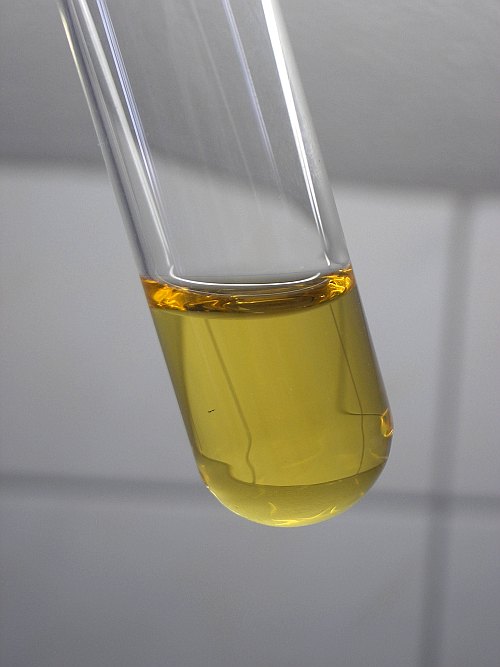
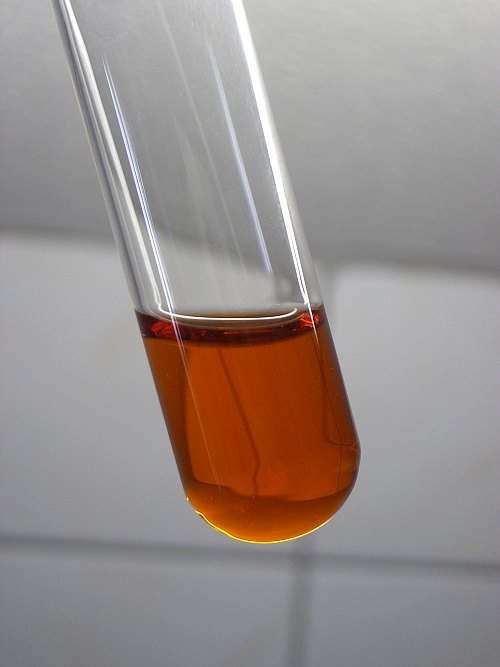
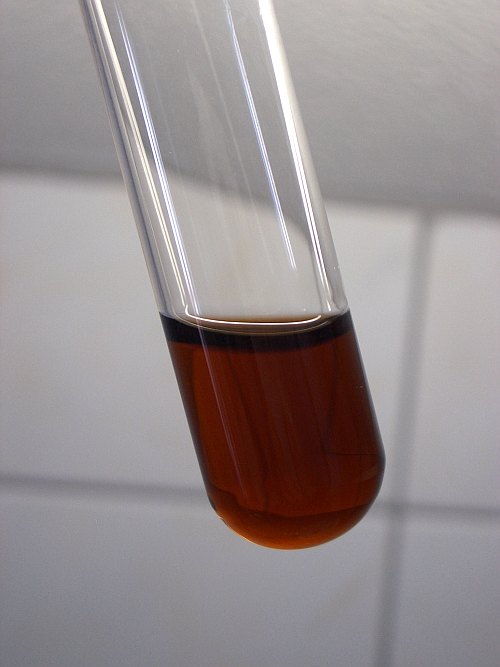
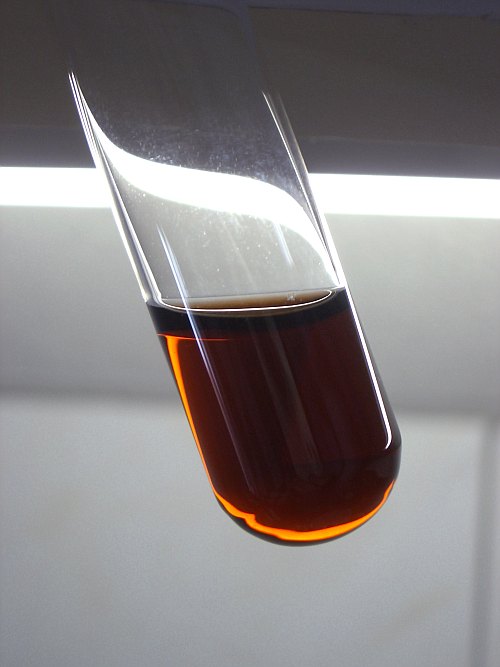
[Edited on 25-3-09 by woelen]
|
|
|
woelen
Super Administrator
        
Posts: 8034
Registered: 20-8-2005
Location: Netherlands
Member Is Offline
Mood: interested
|
|
Acidic solution of ascorbic acid
In acidic solution with ascorbic acid (in 10% H2SO4) the result is totally different. Now there is a shift from yellow through green to dark blue:
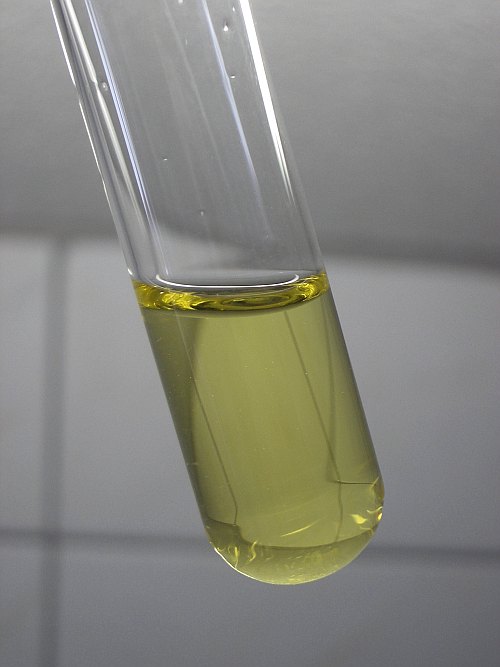
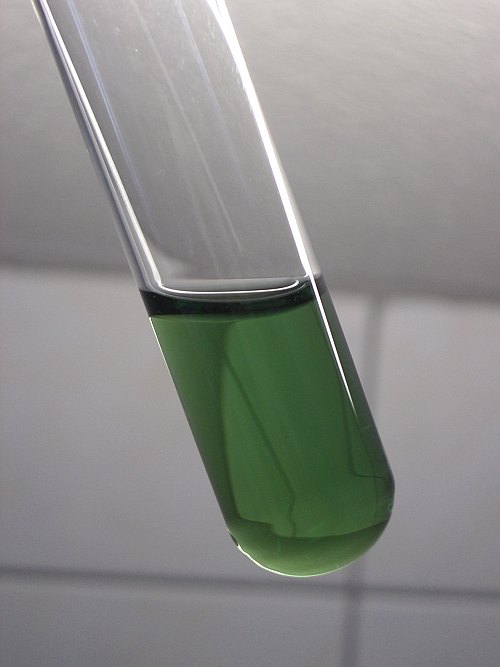
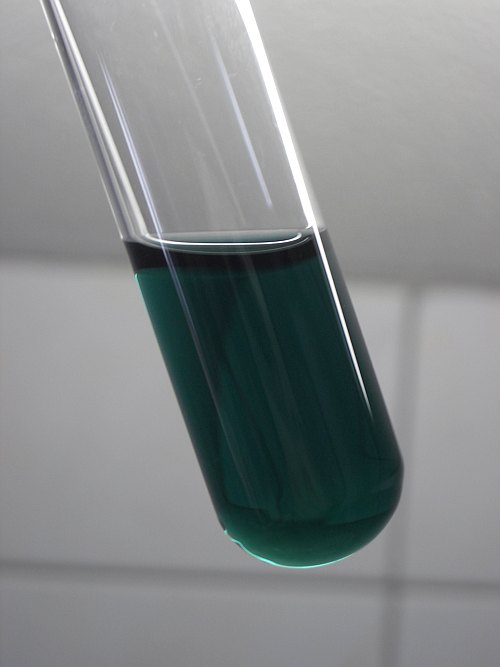
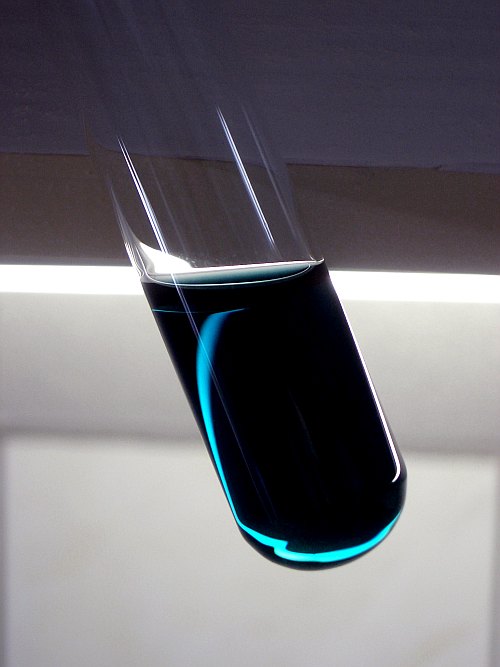
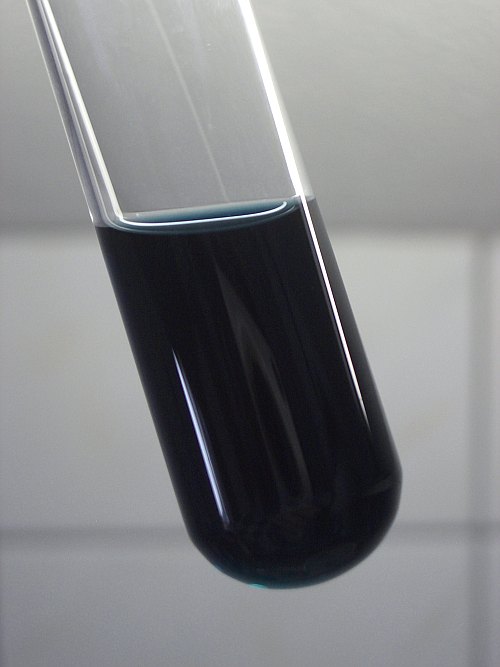
[Edited on 25-3-09 by woelen]
|
|
|
woelen
Super Administrator
        
Posts: 8034
Registered: 20-8-2005
Location: Netherlands
Member Is Offline
Mood: interested
|
|
Hypophosphorous acid solution
With hypophosphorous acid a pure blue solution is formed. The difference most likely is not in the reduction of molybdenum(+6) to molybdenum(+5), but
in the initial complex formation with ascorbic acid. Apparently, molybdenum(+6) forms a yellow complex with ascorbate and ascorbic acid. This explains
the initial yellow color and the later green color in the ascorbic acid sequence of pictures. With hypophosphorous acid no such yellow complex is
formed and the liquid simply turns from colorless to dark blue through shades of blue.
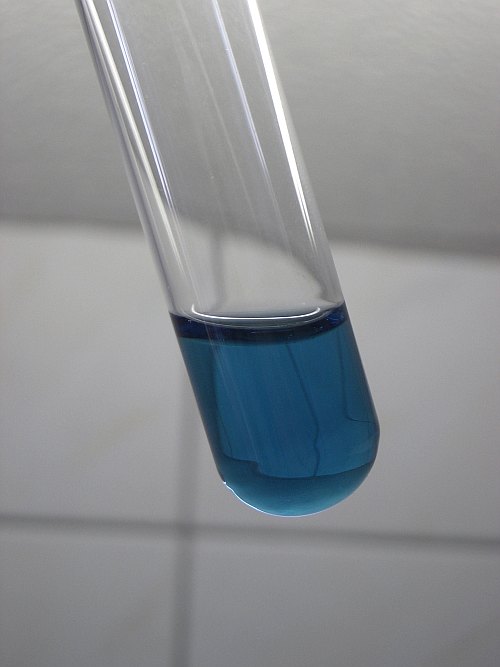
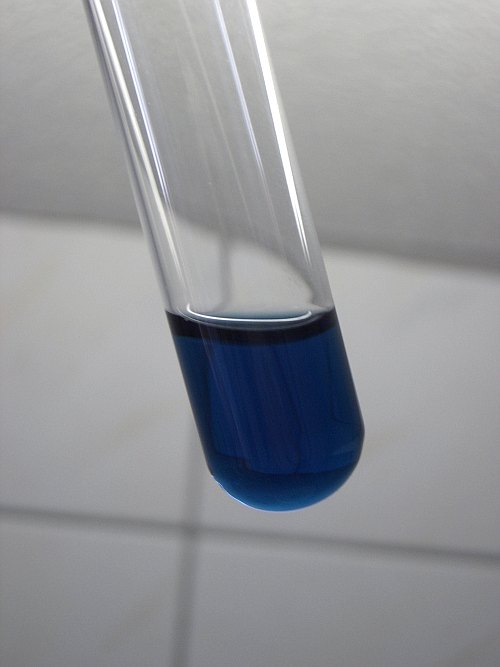
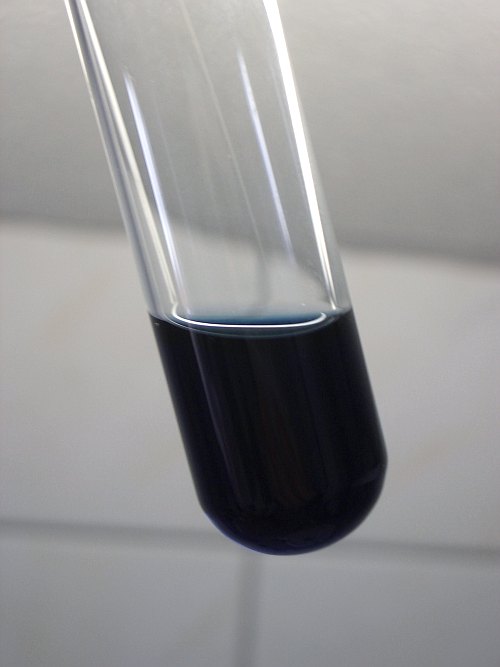
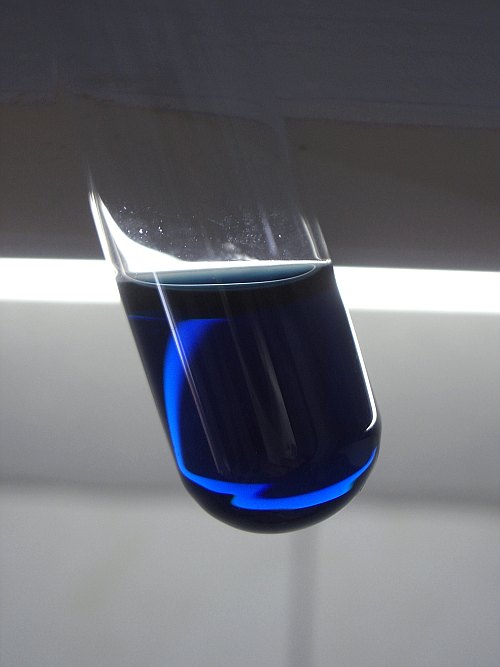
[Edited on 25-3-09 by woelen]
|
|
|
UnintentionalChaos
International Hazard
    
Posts: 1454
Registered: 9-12-2006
Location: Mars
Member Is Offline
Mood: Nucleophilic
|
|
Quote: Originally posted by Jor  |
Quite remarkable that the seller sells 390g of cadmium to any random individual for 10 UK pounds. Not something Greenpeace would be happy with. Who
would want to buy such a large amount of cadmium anyway? That metal is about as toxic as mercury, if not more. |
For those in the US, you can buy good quality lead, tin, antimony, cadmium, zinc, and zinc here: http://www.rotometals.com/ I placed quite a large order...cadmium isn't regulated or anything, just not something 99.9% of people would want to
have kicking around...I have a pound for example for element collection purposes and maybe for some cadmium pigments.
As for the ebay shop "The Mists of Avalon" with all the metals in the UK, I can attest that they are a good source as well.
Beautiful stuff woelen!
Department of Redundancy Department - Now with paperwork!
'In organic synthesis, we call decomposition products "crap", however this is not a IUPAC approved nomenclature.' -Nicodem
|
|
|
pantone159
National Hazard
   
Posts: 590
Registered: 27-6-2006
Location: Austin, TX, USA
Member Is Offline
Mood: desperate for shade
|
|
Very nice photos, woelen, I always really like your stuff.
Makes me sad that I can't get hypophosphorous acid in the USA. 
|
|
|
woelen
Super Administrator
        
Posts: 8034
Registered: 20-8-2005
Location: Netherlands
Member Is Offline
Mood: interested
|
|
I now made a webpage about this experiment set:
http://woelen.homescience.net/science/chem/exps/colorfulmoly...
The pictures you may have seen before, but I also now have a good description of the experiments, so that others can repeat them if they wish. I very
much like the colorful chemistry of molybdenum, the more so, because it is not the first thing which comes to mind when one is speaking about colorful
chemistry.
Btw, no sodium hypophosphite or hypophosphorous acid is needed for the experiments, many other reductors are suitable (e.g. zinc powder, sodium
sulfite, sodium dithionite).
|
|
|
bfesser
Resident Wikipedian
    
Posts: 2114
Registered: 29-1-2008
Member Is Offline
Mood: No Mood
|
|
Beautiful photos and excellent writeup, as always, woelen! Keep up the good work.
|
|
|